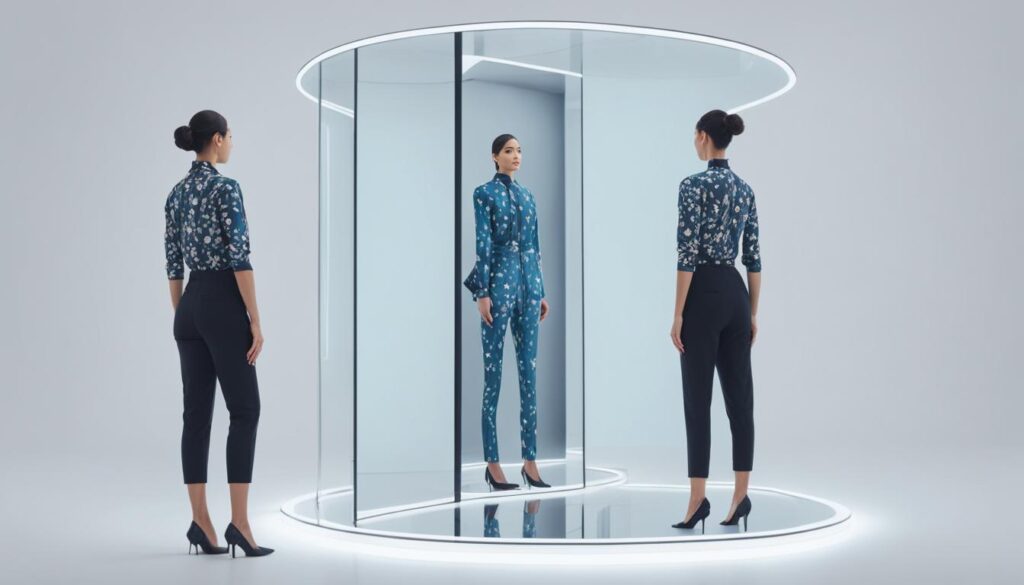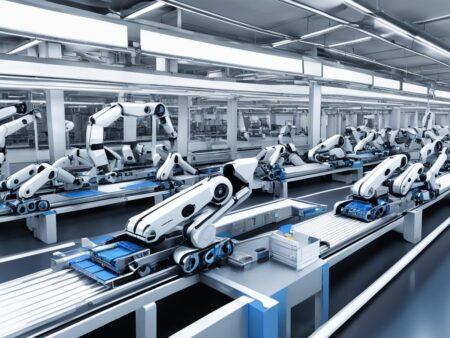Welcome to our comprehensive guide on the revolutionary transformation happening in the fashion industry. Artificial Intelligence (AI) is disrupting the way we create, design, and consume fashion. In this article, we will explore how AI is changing the landscape of the fashion industry, particularly in the realm of clothing changes. Through AI-powered technology, the process of changing clothes is becoming automated and smart. Let’s dive deeper into the various ways AI is transforming the fashion industry.
Trend Forecasting with AI
At our fingertips, we have an overwhelming amount of clothing options. From vibrant colors to intricate designs, staying up to date with the latest fashion trends can be challenging for both consumers and fashion brands. That’s where AI comes in. By leveraging the power of artificial intelligence and machine learning algorithms, trend forecasting has become more accurate and efficient than ever before.
AI has the ability to analyze massive volumes of data from various sources such as social media, fashion blogs, and e-commerce platforms. By identifying patterns and understanding consumer preferences, AI algorithms can provide fashion brands and retailers with valuable insights into upcoming trends. These trend forecasts help shape decisions about collections, inventory management, and marketing strategies.
With AI-powered trend forecasting, fashion brands can now make informed decisions about what styles and designs to produce. This not only reduces the risk of unsold inventory but also enhances customer satisfaction by offering trendy and desirable products. By staying ahead of the curve, fashion brands can establish themselves as trendsetters in the industry.
To give you a better understanding, here are some key benefits of trend forecasting with AI:
- Accurate trend predictions: AI algorithms can analyze vast amounts of data to identify emerging fashion trends with remarkable precision.
- Timely decision-making: With AI-generated trend forecasts, fashion brands can react quickly to market demands and adjust their collections accordingly.
- Improved inventory management: By understanding what trends are on the horizon, fashion brands can optimize their inventory to meet consumer preferences.
- Enhanced marketing strategies: AI trend forecasts enable fashion brands to tailor their marketing efforts to align with upcoming trends, increasing the effectiveness of their campaigns.
By harnessing the power of AI and trend forecasting, fashion brands can stay ahead of the game, meeting the ever-changing demands of consumers in a dynamic industry.
Top Fashion Trends Predicted by AI
| Trend | Description |
|---|---|
| Floral Prints | AI predicts the resurgence of floral prints in fashion with a modern twist, incorporating bold colors and unconventional patterns. |
| Sustainable Fashion | With growing awareness about sustainability, AI forecasts an increasing demand for eco-friendly and ethically sourced clothing. |
| Chunky Sneakers | AI anticipates the continued popularity of chunky sneakers, blending comfort and style with their oversized silhouette. |
| Gender-Neutral Fashion | As the fashion industry embraces inclusivity, AI predicts a rise in gender-neutral clothing options, catering to a diverse range of preferences. |
| Pastel Shades | AI forecasts a resurgence of pastel shades across fashion, infusing soft hues into clothing designs for a subtle yet captivating look. |
AI and Design Innovation
AI is revolutionizing the world of fashion design by empowering designers with innovative tools and insights. By harnessing the power of artificial intelligence, fashion designers can create cutting-edge designs that resonate with their target audience and push the boundaries of creativity.
One of the key advantages of AI in design innovation is its ability to analyze vast amounts of data, including customer preferences, historical trends, and market insights. By understanding consumer demands and identifying patterns, AI-powered tools can provide valuable suggestions and variations, enabling designers to explore new possibilities and experiment with novel combinations.
The integration of AI in the design process not only speeds up the overall workflow but also enhances creativity. Designers can leverage AI algorithms to generate entirely new designs autonomously, serving as a source of inspiration and expanding the realm of possibilities. This collaboration between human creativity and AI assistance leads to the creation of unique and captivating designs that captivate the fashion world.
To illustrate the impact of AI on fashion design innovation, let’s explore a case study showcasing the collaboration between fashion designer Stella McCartney and the AI design platform, OpenAI. Using machine learning algorithms, the platform analyzed years of McCartney’s previous designs and customer feedback data. It then generated new design variations based on this comprehensive understanding, offering fresh and unique perspectives that complemented McCartney’s distinctive style. This partnership demonstrates how AI can enhance the creative process and create innovative designs while preserving the designer’s unique vision.
The possibilities for AI and design innovation are limitless. With advancements in AI technology, fashion designers can continue to push boundaries, experiment with new aesthetics, and create trend-setting collections. By embracing AI in the design process, fashion brands can stay ahead of the curve and deliver innovative designs that captivate their audience’s imagination.
AI-Driven Design Innovation Benefits:
- Enhanced analysis of customer preferences and market insights
- Increased speed and efficiency in the design process
- Generation of new design variations and combinations
- Inspiration and fresh perspectives for designers
- Empowerment of creativity and experimentation
- Creation of trend-setting and captivating designs
| AI Design Tool | Features |
|---|---|
| Adobe Sensei | AI-powered design suggestions and variations |
| PolyAI | Autonomous design generation and trend forecasting |
| IBM Watson Studio | Data-driven insights for design decision-making |
Personalized Shopping with AI
At our company, we understand the importance of providing a personalized shopping experience for each customer. That’s why we have implemented AI-powered technologies that analyze customer data using machine learning algorithms to offer tailored recommendations and enhance customer satisfaction.
By analyzing various data points such as past purchases, browsing behavior, and customer preferences, our AI algorithms can understand individual tastes and styles. This allows us to curate a personalized selection of products that align with each customer’s unique preferences.
Imagine receiving clothing recommendations that are specifically tailored to your taste, reflecting your personal style and preferences. With our AI-powered platform, we can do just that. Our machine learning algorithms learn from your interactions on our website or app and continuously improve their recommendations over time.
Not only does this personalized shopping experience save customers time and effort in finding the perfect items, but it also adds an element of discovery. Customers can explore new styles and trends that they may not have considered before, all in a personalized and curated way.
Benefits of Personalized Shopping:
- Efficient browsing: Customers are presented with relevant product options, avoiding the need to sift through countless items.
- Increased customer satisfaction: By offering a tailored shopping experience, we enhance customer satisfaction and loyalty.
- Discover new styles: Our AI algorithms suggest items that align with a customer’s preferences while also introducing fresh styles and trends.
- Improved conversion rates: Personalized recommendations increase the likelihood of customers making a purchase.
Our personalized shopping experience powered by AI is the future of online fashion retail. We aim to create an environment where each customer feels valued and receives a customized experience that meets their unique desires. With AI technology, we can revolutionize the way people shop for clothing, elevating the online shopping experience to new heights.
| Information | Benefits |
|---|---|
| Analyzing customer data | More accurate recommendations based on individual preferences |
| Machine learning algorithms | Continuously improving recommendations over time |
| Saved time and effort | Efficient browsing and finding the perfect items |
| Increased customer satisfaction | Enhanced loyalty and positive shopping experience |
| Discover new styles and trends | Introducing customers to fresh fashion options |
| Improved conversion rates | Increased likelihood of making a purchase |
Virtual Try-On and Fit with AI
Trying on clothes before making a purchase is a crucial part of the shopping experience. It helps us ensure that the garments fit our body dimensions and align with our personal style. However, with the rise of online shopping, physically trying on clothes has become a challenge. This is where AI-powered virtual try-on technologies come into play.
AI-powered virtual try-on allows customers to visualize how clothing items will look on them without the need for physical interaction. By leveraging computer vision and augmented reality, these technologies create a virtual fitting room experience, revolutionizing the way we shop for clothes.
With AI-powered virtual try-on, customers can explore different outfits, styles, and colors in the comfort of their own homes. By utilizing computer vision, customers can virtually try on clothes and see how they fit and flatter their body dimensions. They can analyze the drape, length, and overall look of the garment, providing a realistic representation of how it would appear in real life.
Augmented reality takes virtual try-on to the next level by overlaying the virtual clothing onto the customer’s live image. This creates an immersive and interactive experience, allowing customers to see themselves wearing the clothes from different angles and perspectives. It enables them to make more informed decisions about their purchase, enhancing their confidence in buying online.
Not only does virtual try-on enhance the online shopping experience, but it also has the potential to reduce return rates. By accurately visualizing how clothes will fit and look on their body, customers can make confident purchasing decisions. This results in a better fit and reduces the need for returns due to dissatisfaction with the garment.
Furthermore, AI can assist in measuring body dimensions accurately, helping customers find the perfect fit. By utilizing computer vision algorithms, AI can estimate measurements such as chest, waist, hips, and inseam length, providing personalized fit recommendations. This minimizes the guesswork when selecting the right size and improves overall customer satisfaction.
AI-powered virtual try-on and fit technologies are transforming the way we shop for clothes online. They provide a realistic and interactive experience, allowing customers to try before they buy and make confident purchasing decisions. With the ability to accurately measure body dimensions and recommend the right fit, AI is revolutionizing the online shopping landscape.

Benefits of AI-Powered Virtual Try-On and Fit
| Benefits | Description |
|---|---|
| Enhanced online shopping experience | Virtual try-on technologies provide a realistic and interactive experience for customers, allowing them to visualize how clothes will look and fit without physical interaction. |
| Reduction in return rates | By accurately representing how clothes will fit and look on the customer, virtual try-on reduces the need for returns due to dissatisfaction with the garment. |
| Accurate measurement of body dimensions | AI can assist in measuring body dimensions accurately, providing customers with personalized fit recommendations and reducing the guesswork in size selection. |
| Confident purchasing decisions | Visualizing how clothes will look and fit on their body gives customers the confidence to make informed purchasing decisions. |
Optimizing the Fashion Supply Chain with AI
In the ever-evolving landscape of the fashion industry, supply chain optimization plays a crucial role in meeting consumer demands efficiently. With the advent of artificial intelligence (AI), fashion brands can now utilize advanced algorithms and data analysis to optimize inventory management, demand forecasting, and logistics. By harnessing the power of AI, we can revolutionize the way fashion supply chains operate, bringing efficiency and agility to every step of the process.
AI-powered modules can analyze vast amounts of data from diverse sources, such as sales records, weather patterns, and market trends, to generate accurate demand forecasts. These forecasts provide valuable insights into consumer preferences and help fashion brands make informed decisions regarding purchasing and production. By accurately predicting demand, brands can significantly reduce the risk of overstocking, minimizing the financial impact of excess inventory.
Furthermore, AI algorithms can optimize inventory management by continuously monitoring supply and demand dynamics, automatically reordering stock when necessary. This proactive approach helps maintain optimal inventory levels, preventing stockouts and ensuring consistent availability of popular items. With AI-powered inventory management, fashion brands can strike a delicate balance between meeting customer demands and minimizing inventory holding costs.
Logistics is another critical aspect of the fashion supply chain that can benefit from AI optimization. By leveraging real-time data and predictive analytics, AI algorithms can optimize shipping routes, delivery schedules, and transportation modes. This optimization not only reduces shipping costs but also improves the overall efficiency of the supply chain, ensuring timely delivery of products to customers.
With AI-driven supply chain optimization, fashion brands can streamline operations, reduce costs, and enhance customer satisfaction. By aligning inventory levels with consumer demand, brands can minimize stockouts and maximize sales opportunities, ultimately leading to increased profitability. Additionally, efficient logistics improve order fulfillment and delivery, resulting in satisfied customers who receive their purchases promptly.
By embracing AI in supply chain optimization, fashion brands can stay one step ahead in a highly competitive market. The ability to analyze vast amounts of data, accurately forecast demand, and optimize inventory and logistics operations creates a responsive and agile supply chain that can adapt to changing market trends and customer behaviors.
In conclusion, AI is revolutionizing the fashion industry by offering powerful tools for supply chain optimization. Through AI-driven inventory management, demand forecasting, and logistics optimization, fashion brands can enhance their operational efficiency, reduce costs, and meet customer demands with precision. Embracing AI in the fashion supply chain unlocks a myriad of possibilities, ultimately shaping a more sustainable, profitable, and customer-centric industry.
AI and Sustainability in Fashion
As the fashion industry grapples with environmental challenges, AI emerges as a transformative force driving sustainability and ethical practices. By harnessing the power of AI and analyzing supply chain data, we can achieve transparency, traceability, and responsible sourcing.
AI enables the fashion industry to trace and verify the origins of materials, ensuring ethical practices throughout the supply chain. By analyzing vast amounts of data, AI algorithms provide valuable insights into the sourcing and production processes, flagging any potential issues and enabling corrective actions.
Furthermore, AI plays a pivotal role in optimizing production processes, reducing waste, and improving energy efficiency. By leveraging AI-driven algorithms, manufacturers can optimize material utilization, minimize excess inventory, and streamline their operations. This not only benefits the bottom line but also contributes to a greener and more sustainable fashion industry.
When it comes to sustainability, AI also empowers fashion brands and consumers to make more informed choices. Through AI-powered platforms, consumers can access transparent information about the environmental impact of different products, enabling them to make sustainable purchasing decisions. This commitment to sustainability drives demand for environmentally responsible practices throughout the fashion supply chain.
With AI as a key enabler, the fashion industry can transition towards a more sustainable future. Through responsible sourcing, optimized production processes, and informed consumer choices, we can create a fashion ecosystem that fosters sustainability and ethical practices.
| Benefits of AI in Promoting Sustainability | Actions |
|---|---|
| Transparency in supply chain | AI analyzes supply chain data to trace and verify the origins of materials, ensuring transparency and responsible sourcing. |
| Optimized production processes | AI-driven algorithms optimize production processes, reducing waste, minimizing excess inventory, and improving energy efficiency. |
| Informed consumer choices | AI-powered platforms provide consumers with transparent information about the environmental impact of products, empowering them to make sustainable purchasing decisions. |
AI in Influencer Marketing
In today’s digital age, influencer marketing has become a powerful tool for fashion brands to reach their target audience. However, finding the right influencers who can authentically represent a brand and engage their followers can be a challenge. This is where AI comes in.
By leveraging AI technology, fashion brands can analyze vast amounts of social media data, including follower demographics, engagement rates, and content relevancy. AI algorithms can identify suitable influencers who align with the brand’s target audience, ensuring that their marketing campaigns have a greater impact.
AI can also help to simplify the process of influencer selection by providing valuable insights and recommendations based on social media data analysis. Brands can quickly identify influencers who have a genuine influence and can effectively promote their products or services.
Moreover, AI can evaluate influencers’ engagement rates, ensuring that brands partner with influencers who have an active and engaged audience. This data-driven approach helps maximize the effectiveness of influencer marketing campaigns and ensures a higher return on investment.
With AI-powered influencer marketing, fashion brands can make informed decisions, collaborate with the right influencers, and deliver targeted messages to their desired audience, ultimately driving brand awareness, engagement, and revenue.
Benefits of AI in Influencer Marketing
- Efficient analysis of social media data
- Identification of suitable influencers
- Improved targeting and audience reach
- In-depth evaluation of engagement rates
- Optimized influencer selection process
| Benefit | Description |
|---|---|
| Efficient analysis of social media data | AI algorithms can analyze vast amounts of social media data, providing valuable insights for influencer marketing strategies. |
| Identification of suitable influencers | AI can identify influencers who align with a brand’s target audience, demographics, and content relevancy, ensuring effective partnerships. |
| Improved targeting and audience reach | By collaborating with suitable influencers, brands can reach a wider and more relevant audience, increasing the effectiveness of their campaigns. |
| In-depth evaluation of engagement rates | AI can evaluate influencers’ engagement rates, helping brands select influencers with an active and engaged audience. |
| Optimized influencer selection process | With AI-powered data analysis, brands can streamline and optimize the influencer selection process, saving time and resources. |
AI and the Future of Fashion
AI is revolutionizing the fashion industry, paving the way for a future where innovation and personalized experiences are at the forefront. As technology continues to evolve, it empowers us to streamline operations, drive creativity, and reimagine how we interact with fashion.
In this ever-changing landscape, AI acts as a catalyst for transformative ideas and possibilities. It enables us to explore new horizons and push the boundaries of what is possible in the realm of fashion. From trend forecasting and design innovation to personalized shopping experiences, AI has the potential to reshape the entire industry.
With AI-powered trend forecasting, fashion brands can stay one step ahead by analyzing vast amounts of data, from social media and fashion blogs to consumer preferences. This enables us to accurately predict upcoming trends, align our collections, and cater to the ever-changing demands of our customers.
AI also unlocks a world of design innovation by assisting fashion designers in generating cutting-edge ideas. By analyzing customer preferences, historical trends, and market insights, AI-powered tools can suggest design variations and new concepts, enhancing creativity and speeding up the design process.
The future of fashion lies in personalized experiences, and AI is at the forefront of making this vision a reality. By analyzing customer data, AI algorithms can provide tailored recommendations, making the shopping journey more intuitive, efficient, and enjoyable.
Virtual try-on technologies, powered by AI and computer vision, allow customers to visualize how clothing items will look and fit without physically trying them on. This empowers shoppers to make confident decisions, while also reducing the environmental impact of returns.
A sustainable future for fashion is also within reach, thanks to AI. By analyzing supply chain data and optimizing production processes, AI can promote transparency, ethical practices, and waste reduction.
As we look to the future, AI will continue to shape the fashion industry by offering endless possibilities for innovation and personalization. The harmonious integration of style and technology will redefine the way we create, consume, and experience fashion.
AI-Driven Fashion Design: Unveiling the Creative Potential
In the world of fashion design, AI-powered technology has emerged as a groundbreaking tool that pushes the boundaries of imagination. By harnessing the power of AI algorithms, designers can effectively analyze historical trends and consumer preferences to create designs that captivate and resonate with their target audience. This fusion of artificial intelligence and fashion design unlocks a new realm of creative potential and innovation.
AI-powered fashion design takes inspiration from the past to shape the future. Through meticulous analysis of historical trends, AI algorithms can identify patterns and uncover hidden insights. By understanding the evolution of fashion, designers gain valuable knowledge that informs their creative process.
However, AI goes beyond simply studying the past. It also delves into the present by analyzing consumer preferences and behaviors. By leveraging AI algorithms to extract meaningful insights from vast amounts of data, designers gain a deep understanding of what their target audience desires. This invaluable information allows them to create collections that speak directly to the tastes and aspirations of their customers.
The predictive capabilities of AI offer designers a unique advantage. By accurately forecasting trends based on historical data and consumer preferences, designers can confidently create collections that align with the zeitgeist of the fashion industry. This foresight allows them to stay ahead of the curve and deliver designs that resonate with their audience.
AI-driven fashion design also provides designers with an opportunity for unparalleled creativity and experimentation. By analyzing historical trends and consumer preferences, AI algorithms can generate innovative design variations and combinations. These suggestions serve as a launchpad for designers to explore new territories and create unique pieces that push the boundaries of fashion.
Furthermore, AI-powered fashion design enhances the efficiency and speed of the design process. By automating certain stages of design creation, such as generating initial sketches or exploring design alternatives, designers can focus their time and energy on refining and perfecting their vision.
In conclusion, AI-driven fashion design unlocks a world of creative potential by combining the analysis of historical trends and consumer preferences. With the assistance of AI algorithms, designers can accurately predict trends, create unique collections, and stay ahead of the curve. This fusion of technology and fashion opens up new avenues for creativity and innovation in the ever-evolving world of fashion design.
The Digital Revolution: Virtual Fitting Rooms and Customization
In today’s digital age, the fashion industry is undergoing a transformative shift with the help of AI-powered virtual fitting rooms and customization options. These innovative technologies are revolutionizing the way we shop for clothes, providing a personalized and immersive shopping experience.
Virtual fitting rooms have emerged as game-changers in the fashion industry. They allow shoppers to try on clothes virtually, eliminating the need for physical garments. By leveraging computer vision and augmented reality, these virtual fitting rooms give customers a realistic and interactive way to see how different clothing items will look on them. This technology empowers shoppers to make informed choices, select the perfect size and fit, and envision their style effortlessly.
With virtual fitting rooms, customization takes center stage. Algorithms powered by AI analyze individual preferences and characteristics to curate personalized clothing recommendations. Customers can mix and match different styles, colors, and patterns until they find the perfect combination that reflects their unique taste. This level of customization ensures that each customer feels empowered and satisfied with their purchase, reducing the likelihood of fashion mistakes and returns.
Personalized shopping experiences have become the new norm, as customers increasingly seek unique and tailored options. AI-driven virtual fitting rooms and customization pave the way for a future where each individual can have a wardrobe perfectly suited to their style and body type. This level of personalization not only enhances the shopping experience but also fosters a deeper connection between customers and the brands they love.
Virtual fitting rooms also have a significant impact on sustainability. By reducing the need for physical garment production and transportation, these virtual experiences contribute to a more eco-friendly fashion industry. With AI-powered virtual fitting rooms and customization, fashion brands can minimize waste and the environmental impact associated with excessive production and returns.
The seamless integration of AI-powered virtual fitting rooms and customization options into the fashion industry is changing the landscape of online shopping. As technology continues to advance, we can expect even more innovative developments in the intersection of AI and fashion, offering an unparalleled shopping experience that is both personalized and sustainable.
Smart Fabrics: The Fusion of Technology and Comfort
Smart fabrics are revolutionizing the way we experience clothing. By integrating sensors and advanced technologies, these innovative textiles bring together functionality and comfort to enhance our everyday lives. From fitness wearables to therapeutic garments, smart fabrics offer a range of benefits that elevate the wearer’s experience.
Monitoring Vital Signs
Embedded with sensors, smart fabrics have the capability to monitor vital signs such as heart rate, temperature, and breathing patterns. This technology opens up new possibilities for body monitoring and healthcare applications. Whether it’s a shirt that tracks your heart rate during a workout or pajamas that measure sleep quality, smart fabrics provide real-time insights into our well-being.
Temperature Control and Adaptability
Smart fabrics can also adjust temperature to maximize comfort in changing environments. Whether it’s a self-heating jacket that keeps you warm during cold winter months or moisture-wicking activewear that keeps you cool and dry during intense workouts, these textiles adapt to your body’s needs, ensuring optimal comfort and performance.
Therapeutic Benefits
In addition to monitoring and temperature control, smart fabrics offer therapeutic benefits. For example, pressure-sensing fabrics can assist in managing and preventing pressure sores, benefiting individuals with limited mobility. These fabrics distribute pressure evenly, reducing the risk of discomfort and skin damage.
| Smart Fabric Application | Benefits |
|---|---|
| Sports and Fitness Wearables | Real-time body monitoring, performance optimization |
| Smart Clothing for Healthcare | Vital sign monitoring, remote patient monitoring |
| Therapeutic Garments | Pressure sore prevention, enhanced comfort |
| Climate-Responsive Outerwear | Temperature control, adaptability |
Smart fabrics have the potential to revolutionize various industries, including healthcare, sports, and fashion. With ongoing advancements in sensor technology and textile innovation, we can expect even more sophisticated and versatile smart fabrics in the future.
AI and Sustainability: Reducing Fashion’s Environmental Footprint
In our quest for a more sustainable future, AI is playing a crucial role in minimizing the fashion industry’s environmental impact. By harnessing the power of AI, we can optimize production processes, reduce waste, and promote recycling initiatives, making fashion more sustainable than ever before.
Optimizing Production Processes
AI algorithms analyze supply chain data to streamline production processes, minimizing inefficiencies and resource wastage. By identifying areas for improvement, AI enables manufacturers to optimize energy consumption, reduce water usage, and minimize the emission of harmful chemicals. This leads to more sustainable and eco-friendly manufacturing practices.
Reducing Waste
Another way AI contributes to sustainability in fashion is by reducing waste throughout the supply chain. By analyzing historical data and market trends, AI algorithms can make accurate demand forecasts, enabling fashion brands to produce only what is needed, reducing overproduction and avoiding excess inventory. This not only prevents wastage of resources but also minimizes the amount of unsold garments that may end up in landfills.
Promoting Recycling Initiatives
AI technologies are also driving recycling initiatives in the fashion industry. AI-powered sorting systems can accurately categorize different materials in clothing items, making the recycling process more efficient. This enables the extraction and reuse of valuable resources from old garments, reducing the need for virgin materials and lowering the overall environmental impact of fashion production.

By leveraging AI’s capabilities, we can usher in a more sustainable future for the fashion industry. From optimizing production processes and reducing waste to promoting recycling initiatives, AI is revolutionizing the way we approach fashion, ensuring a greener and more environmentally friendly industry.
AI and the Shopping Experience: From Pixels to Purchase
At the intersection of AI and fashion, the shopping experience has been revolutionized. Gone are the days of frustrating searches for that perfect item you saw online but couldn’t find anywhere. With AI-powered fashion image recognition, shopping has become more accessible and instantaneous than ever before.
Imagine this: you come across a stunning outfit in a magazine or on social media. You snap a photo, and AI technology goes to work. Using advanced image recognition algorithms, AI can identify the clothing items in the photo and provide you with instant information and options for purchase.
Through automatic fashion image recognition, AI can now recognize patterns, colors, and styles, allowing shoppers to find similar or identical items with just a few clicks. Whether it’s a dress worn by your favorite celebrity or a trendy accessory spotted on the street, AI can help you locate and purchase those fashion gems.
But AI’s influence on the shopping experience doesn’t stop there. Online shopping has become more personalized and efficient, thanks to AI algorithms that analyze consumer data and preferences. From personalized product recommendations to tailored shopping experiences, AI ensures that every click and scroll brings you closer to finding exactly what you’re looking for.
With the rise of AI, fashion retailers can now offer a curated selection of products that align with your style, size, and budget. AI algorithms take into account your browsing history, purchase behavior, and even social media activity to understand your unique preferences. This tailored approach ensures that you are presented with relevant options, saving you time and effort while enhancing your overall shopping experience.
Furthermore, AI-powered virtual try-on technologies are transforming the way we shop for clothing online. By using computer vision and augmented reality, shoppers can virtually try on clothes, visualizing how they will look and fit without physically trying them on. This technology not only reduces the likelihood of purchasing ill-fitting items but also adds an element of fun and exploration to the online shopping process.
AI has brought a new level of convenience and efficiency to the shopping experience. By leveraging the power of AI, fashion retailers can provide a seamless and personalized shopping journey, catering to individual preferences and enhancing customer satisfaction.
As AI continues to evolve, we can expect even more exciting innovations in the realm of fashion and online shopping. From AI-powered style assistants to virtual showrooms, the future of fashion retail is being shaped by the intelligent capabilities of AI.
Conclusion
The future of fashion is being shaped by AI-powered technology, revolutionizing the industry and offering endless possibilities for creativity, personalization, and sustainability. From trend forecasting to personalized shopping experiences, AI has become an integral part of the fashion world.
The integration of artificial intelligence and clothing opens up new avenues for innovation and design. Fashion designers can leverage AI to analyze consumer preferences and create unique collections that resonate with their target audience. By understanding market trends and historical data, AI algorithms assist designers in pushing the boundaries of imagination.
Furthermore, AI enhances the shopping experience by providing personalized recommendations and virtual try-ons. By analyzing customer data and leveraging machine learning algorithms, fashion retailers can curate tailored shopping experiences for each individual. Virtual fitting rooms and AI-powered image recognition technology make fashion more accessible, instantaneous, and inclusive.
As the fashion industry continues to evolve, AI also plays a vital role in promoting sustainability and ethical practices. By analyzing supply chain data, AI technology can trace and verify the origins of materials, ensuring transparency and ethical sourcing. It can also optimize production processes, reducing waste and improving energy efficiency.
The future of fashion lies in the fusion of technology and clothing. With AI-powered fashion, we can expect a stylish and innovative industry where creativity knows no bounds, personalization is key, and sustainability is at the forefront. As AI continues to advance, it will undoubtedly reshape the fashion landscape, ushering in a new era of cutting-edge designs and unforgettable experiences.
FAQ
Q: How is AI revolutionizing the fashion industry?
A: AI is transforming the fashion industry by changing the way we create, design, and consume fashion. It offers smart, automated solutions for wardrobe changes, trend forecasting, design innovation, personalized shopping, virtual try-on and fit, supply chain optimization, sustainability, influencer marketing, and more.
Q: How can AI help fashion brands with trend forecasting?
A: AI can analyze large volumes of data from social media, fashion blogs, and e-commerce platforms to predict upcoming fashion trends. By identifying patterns and consumer preferences, AI algorithms can provide accurate trend forecasts, helping fashion brands and retailers make informed decisions about collections, inventory, and marketing strategies.
Q: How does AI assist fashion designers in generating innovative designs?
A: AI-powered tools can suggest design variations, combinations, and even generate new designs autonomously by analyzing customer preferences, historical trends, and market insights. This enhances creativity and speeds up the design process, enabling fashion designers to create innovative designs.
Q: How does AI enable personalized shopping experiences?
A: By analyzing customer data, including past purchases, browsing behavior, and preferences, AI can leverage machine learning algorithms to provide tailored recommendations to individual customers. This enhances customer satisfaction and drives sales, offering personalized shopping experiences.
Q: How do AI-powered virtual try-on technologies work?
A: AI-powered virtual try-on technologies use computer vision and augmented reality to allow customers to visualize how clothing items will look on them without physically trying them on. Customers can virtually try different outfits, styles, and colors, improving the overall online shopping experience.
Q: How can AI optimize the fashion supply chain?
A: By analyzing data from various sources, including sales, weather patterns, and market trends, AI algorithms can enhance inventory accuracy, reduce overstocking or understocking issues, and optimize the production and distribution process. This improves inventory management, demand forecasting, and logistics in the fashion supply chain.
Q: How does AI promote sustainability and ethical practices in the fashion industry?
A: AI can analyze supply chain data to trace and verify the origins of materials, ensuring transparency and ethical sourcing. It can also optimize production processes, reducing waste and improving energy efficiency. This promotes sustainability and ethical practices in the fashion industry.
Q: How does AI help identify suitable influencers for fashion brands?
A: By analyzing social media data, follower demographics, engagement rates, and content relevancy, AI can identify suitable influencers for fashion brands. This allows brands to collaborate with influencers who align with their target audience, leading to more effective influencer marketing campaigns.
Q: What is the role of AI in the future of fashion?
A: AI has the potential to streamline operations, drive innovation, and create personalized experiences in the fashion industry. It is continuously evolving and offers a glimpse into a future where style and technology dance harmoniously, shaping the future of fashion.
Q: How does AI influence fashion design?
A: AI in fashion design involves the analysis of historical trends and consumer preferences to create designs that push the boundaries of imagination. AI algorithms assist designers in predicting trends and creating unique collections that resonate with the target audience.
Q: How do virtual fitting rooms enhance the shopping experience?
A: Virtual fitting rooms allow shoppers to try on clothes virtually, eliminating the need for physical garments. Algorithms analyze individual preferences and characteristics to curate personalized clothing options, enhancing the shopping experience and reducing the likelihood of fashion mistakes.
Q: What are smart fabrics and how do they enhance comfort?
A: Smart fabrics are embedded with sensors that can monitor vital signs, adjust temperature, and offer therapeutic benefits. From self-heating jackets to moisture-wicking activewear, smart fabrics enhance comfort and functionality in clothing.
Q: How does AI reduce fashion’s environmental footprint?
A: AI helps optimize production processes, reduce waste, and promote recycling initiatives, making the fashion industry more environmentally friendly and sustainable. By analyzing supply chain data, AI identifies areas for improvement, leading to a reduction in fashion’s environmental footprint.
Q: How does AI enhance the online shopping experience?
A: AI enhances the shopping experience by using image recognition technology to identify clothing items from photos and redirect shoppers to online stores. This makes fashion more accessible and instantaneous, improving the overall online shopping experience.
Q: What is the future of AI-powered fashion?
A: The integration of AI and clothing continues to shape the future of fashion, promising a stylish and innovative industry. AI-driven fashion offers avenues for creativity, personalization, sustainability, and technology, creating a bright future for the fashion industry.









